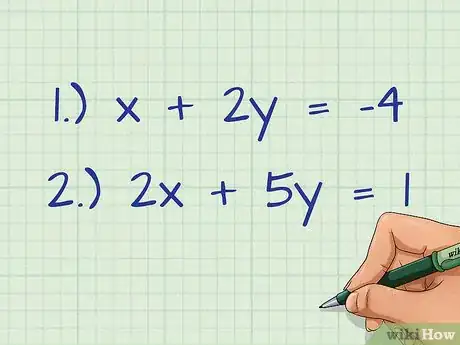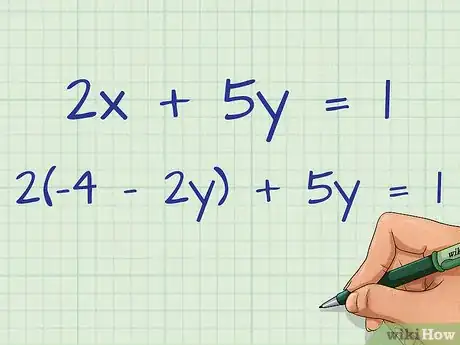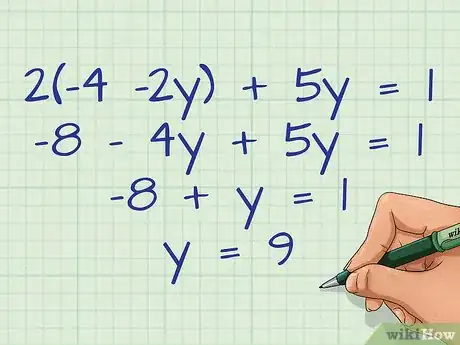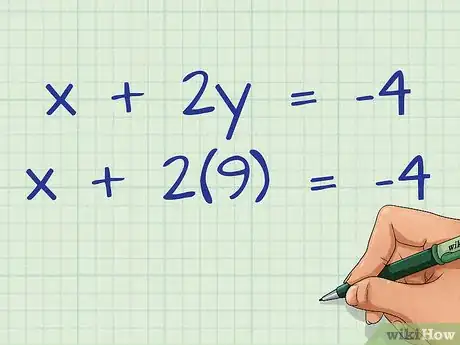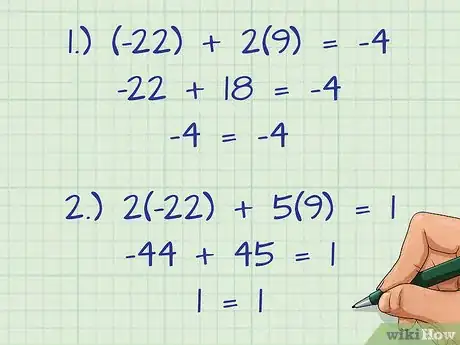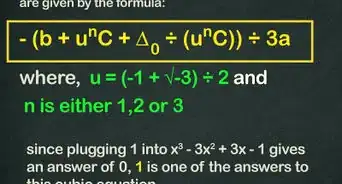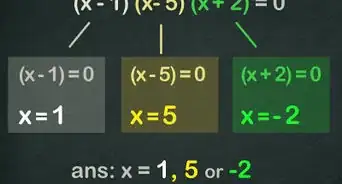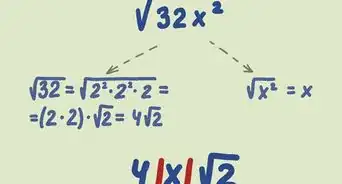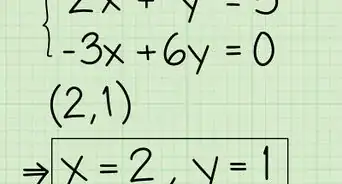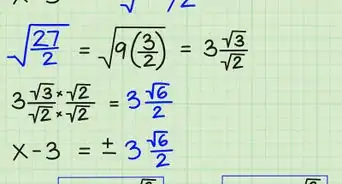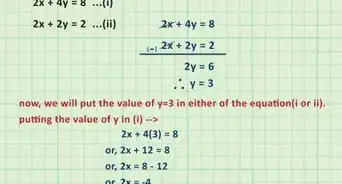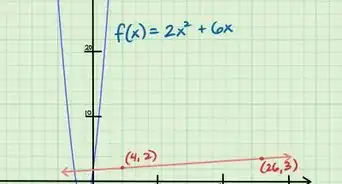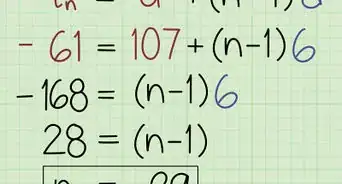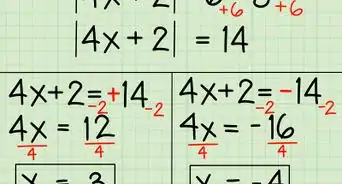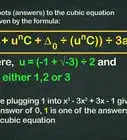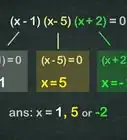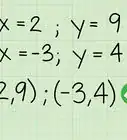This article was co-authored by wikiHow Staff. Our trained team of editors and researchers validate articles for accuracy and comprehensiveness. wikiHow's Content Management Team carefully monitors the work from our editorial staff to ensure that each article is backed by trusted research and meets our high quality standards.
This article has been viewed 190,333 times.
Learn more...
Simultaneous equations are two linear equations with two unknown variables that have the same solution. Solving equations with one unknown variable is a simple matter of isolating the variable; however, this isn’t possible when the equations have two unknown variables. By using the substitution method, you must find the value of one variable in the first equation, and then substitute that variable into the second equation.[1] While it involves several steps, the substitution method for solving simultaneous equations requires only basic algebra skills.
Steps
Finding the Value of y
-
1Choose the equation you want to work with first. It doesn’t matter which equation you choose, but you might want to look for one that will give you numbers that are easier to work with.[2]
- For example, if your simultaneous equations are 1) and 2) , you will probably want to begin with the first equation, because the is already by itself.
-
2Isolate the variable in the first equation. You could also start by isolating the y variable (or whatever other variable the equation uses).[3]
- For example, if you are beginning with , you could solve for by subtracting 2y from each side.
Advertisement - For example, if you are beginning with , you could solve for by subtracting 2y from each side.
-
3Plug in the value of into the second equation. Place the value in parentheses for clarity.[4]
- For example, if you found in the first equation, plug in for in the second equation:
- For example, if you found in the first equation, plug in for in the second equation:
-
4Find the value of in the second equation. Remember to follow the order of operations.[5]
- For example, to solve for in the equation , first use the distributive property to multiply.
- For example, to solve for in the equation , first use the distributive property to multiply.
Finding the Value of x
-
1Plug in the value into either equation. It doesn’t matter which equation you use, as long as you use the original equation, or an equation where you’ve isolated the variable. This will allow you to find the value for .[6]
- If you plug the value back into the second equation with the substitution, you will not be able to find the value of .[7]
- For example, if you found , plug in for in the first equation:
-
2Find the value of . Remember to follow the order of operations.[8]
- For example, to solve for in the equation , first multiply, and then subtract 18 from each side to find the value of .
.
- For example, to solve for in the equation , first multiply, and then subtract 18 from each side to find the value of .
-
3Check your work. To do this, substitute the values you found for and into both equations, and verify that the resulting equation are true.[9]
- For example, if you found and , substitute these values into both equations.
- So, for the first equation:
- For the second equation:
Community Q&A
-
QuestionIs there an easier method for simultaneous equations than what is already on this website?
 DonaganTop AnswererNot really. Here's the simplest example possible: let's say x + y = 3 and x - y = 1. Solve the second equation for x by adding y to both sides: (x - y) + y = 1 + y. So x = 1 + y. Take that value of x, and substitute it into the first equation given above (x + y = 3). With that substitution the first equation becomes (1+y) + y = 3. That means 1 + 2y = 3. Subtract 1 from each side: 2y = 2. So y = 1. Substitute that value of y into either of the two original equations, and you'll get x = 2.
DonaganTop AnswererNot really. Here's the simplest example possible: let's say x + y = 3 and x - y = 1. Solve the second equation for x by adding y to both sides: (x - y) + y = 1 + y. So x = 1 + y. Take that value of x, and substitute it into the first equation given above (x + y = 3). With that substitution the first equation becomes (1+y) + y = 3. That means 1 + 2y = 3. Subtract 1 from each side: 2y = 2. So y = 1. Substitute that value of y into either of the two original equations, and you'll get x = 2. -
QuestionIs 3x + 4y = 52 and 5x + y = 30 solvable by substitution? I've tried solving twice and I just can't get the last part right.
 DonaganTop AnswererYes, it's solvable. Take the second equation, and subtract 5x from both sides: y = (30 - 5x). Plug that value of y back into the other equation: 3x + 4(30 - 5x) = 52. So (3x + 120 - 20x) = 52, and (-17x + 120) = 52. Then (-17x) = -68, and x = 4. Plug that value of x into either of the original equations: 3(4) + 4y = 52, so 12 + 4y = 52, and 4y = 40, so that y = 10. Check your work by plugging the found values of x and y into either of the original equations.
DonaganTop AnswererYes, it's solvable. Take the second equation, and subtract 5x from both sides: y = (30 - 5x). Plug that value of y back into the other equation: 3x + 4(30 - 5x) = 52. So (3x + 120 - 20x) = 52, and (-17x + 120) = 52. Then (-17x) = -68, and x = 4. Plug that value of x into either of the original equations: 3(4) + 4y = 52, so 12 + 4y = 52, and 4y = 40, so that y = 10. Check your work by plugging the found values of x and y into either of the original equations. -
QuestionWhich is easiest between the elimination, graphical, and substitution methods of solving simultaneous equations?
 Community AnswerIt depends on what kind of equation you have. One skill you should develop is knowing when to use what so you can manage your time wisely.
Community AnswerIt depends on what kind of equation you have. One skill you should develop is knowing when to use what so you can manage your time wisely.
References
- ↑ http://www.mathsteacher.com.au/year9/ch05_simult/01_sub/method.htm
- ↑ http://www.purplemath.com/modules/systlin4.htm
- ↑ https://flexbooks.ck12.org/cbook/ck-12-cbse-math-class-10/section/3.5/primary/lesson/solving-simultaneous-linear-equations-by-substitution/
- ↑ https://www.khanacademy.org/math/cc-eighth-grade-math/cc-8th-systems-topic/cc-8th-systems-with-substitution/a/systems-of-equations-with-substitution
- ↑ https://www.bbc.co.uk/bitesize/guides/zd9dmp3/revision/2
- ↑ https://www.bbc.co.uk/bitesize/guides/zd9dmp3/revision/2
- ↑ http://www.purplemath.com/modules/systlin4.htm
- ↑ https://www.khanacademy.org/math/cc-eighth-grade-math/cc-8th-systems-topic/cc-8th-systems-with-substitution/a/systems-of-equations-with-substitution
- ↑ https://flexbooks.ck12.org/cbook/ck-12-cbse-math-class-10/section/3.5/primary/lesson/solving-simultaneous-linear-equations-by-substitution/
